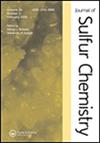Design and synthesis of abietic acid derivatives containing sulfonamide structure, biological activity and mechanism of action studies
IF 1.6
3区 化学
Q3 CHEMISTRY, MULTIDISCIPLINARY
引用次数: 0
Abstract
Through active splicing techniques and chemical synthesis methods, we have successfully synthesized a series of novel abietic acid derivatives that combine abietic acid backbone with a sulfonamide group. In vitro tests, these derivatives exhibited remarkable antibacterial activities, especially compound C3. Using three-dimensional quantitative structure–activity relationship (3D-QSAR) analysis, we found that the introduction of electron-absorbing groups at the R1 position, as well as the introduction of larger groups at the R2 position, may enhance the antibacterial activity of the target compounds. In addition, studies on the antibacterial mechanism of action of compound C3 showed that it could increase the permeability of bacterial membranes, disrupt the cell membrane of Xanthomonas oryzae pv. oryzicola (Xoc), and effectively inhibit bacterial growth. These findings not only elucidate the antibacterial mechanism of C3, but also provide an important scientific basis for the design and development of new antibacterial agents.
设计合成含磺胺枞酸衍生物的结构、生物活性和作用机理研究
通过主动剪接技术和化学合成方法,我们成功地合成了一系列将松木酸主链与磺胺基结合的新型松木酸衍生物。体外抑菌实验表明,这些衍生物具有明显的抑菌活性,其中化合物C3的抑菌活性最强。通过三维定量构效关系(3D-QSAR)分析,我们发现在R1位置引入电子吸收基团,以及在R2位置引入更大的基团,可以增强目标化合物的抗菌活性。此外,对化合物C3的抑菌作用机制的研究表明,C3可以增加细菌膜的通透性,破坏米黄单胞菌的细胞膜。并能有效抑制细菌生长。这些发现不仅阐明了C3的抗菌机制,也为新型抗菌剂的设计和开发提供了重要的科学依据。
本文章由计算机程序翻译,如有差异,请以英文原文为准。
求助全文
约1分钟内获得全文
求助全文
来源期刊

Journal of Sulfur Chemistry
CHEMISTRY, MULTIDISCIPLINARY-
CiteScore
4.10
自引率
9.10%
发文量
38
审稿时长
6-12 weeks
期刊介绍:
The Journal of Sulfur Chemistry is an international journal for the dissemination of scientific results in the rapidly expanding realm of sulfur chemistry. The journal publishes high quality reviews, full papers and communications in the following areas: organic and inorganic chemistry, industrial chemistry, materials and polymer chemistry, biological chemistry and interdisciplinary studies directly related to sulfur science.
Papers outlining theoretical, physical, mechanistic or synthetic studies pertaining to sulfur chemistry are welcome. Hence the target audience is made up of academic and industrial chemists with peripheral or focused interests in sulfur chemistry. Manuscripts that truly define the aims of the journal include, but are not limited to, those that offer: a) innovative use of sulfur reagents; b) new synthetic approaches to sulfur-containing biomolecules, materials or organic and organometallic compounds; c) theoretical and physical studies that facilitate the understanding of sulfur structure, bonding or reactivity; d) catalytic, selective, synthetically useful or noteworthy transformations of sulfur containing molecules; e) industrial applications of sulfur chemistry; f) unique sulfur atom or molecule involvement in interfacial phenomena; g) descriptions of solid phase or combinatorial methods involving sulfur containing substrates. Submissions pertaining to related atoms such as selenium and tellurium are also welcome. Articles offering routine heterocycle formation through established reactions of sulfur containing substrates are outside the scope of the journal.
 求助内容:
求助内容: 应助结果提醒方式:
应助结果提醒方式:


